INVESTING IN GHANA
Ghana’s geological landscape teems with a variety of minerals. Home to about 25 large-scale mining companies and hundreds of smaller ones, the country exports gold, bauxite and manganese.
The mining industry is one of the key contributors to the country’s economy and is also responsible for development of Ghana’s people and communities, providing jobs as well as infrastructure such as schools, roads and housing.
This important industry relies on hundreds of mining machines, many of them manufactured by Caterpillar. From trucks and shovels that handle production duties to dozers and motor graders that prepare and maintain roads and support the overall operation, Cat® machines are hard at work in Ghanaian mines. And they’re all supported by Cat dealer Mantrac.
Large international mining companies including Newmont, Goldfields, Anglo Gold Ashanti and Consolidated Minerals all operate in the region, along with many other smaller international and local mining houses.
Another key contributor to Ghana’s economy, Mantrac has four facilities in Ghana and employs about 700 people. The dealer serves Caterpillar customers in 10 countries spread across the Middle East, East Africa, West Africa and Russia
Mantrac distributes industry-leading Cat equipment, power solutions, and microgrid solar and energy storage systems, all backed by Mantrac’s maintenance, repair and other support services. The dealer’s comprehensive inventory also includes parts and attachments as well as rental and used machines and power systems.
The company’s most recent contribution is its new Component Rebuild Center (CRC) in Takoradi. The facility was created to rebuild components such as engines, powertrains and hydraulic systems so equipment owners can get maximum performance and reliability throughout the life of their machines. In addition to mining, the CRC also supports the construction, forestry, marine, oil and gas, and electric power sectors.
“Cat machines are designed to deliver long life and to be rebuilt several times,” says Steven Scott, Mantrac Ghana Managing Director. “This CRC makes it possible — helping our customers enjoy several lives from their mining machines.”
By opening its CRC in Takoradi, Mantrac provides its customers an in-country rebuild solution that is efficient and cost-effective. “Our customers need to cost effectively extend the life of their machines through many rebuild cycles,” says Adam Martin, Mantrac Ghana Product Support Manager. “With Mantrac’s CRC there is no need for components to leave the shores of Ghana, and at the same time the rebuild cost is reduced through specialized salvage and rebuild techniques.”
Equipped to rebuild and test all major components of the largest equipment Caterpillar produces today, Cat dealer CRCs meet the same safety, quality and contamination standards as a Caterpillar factory.
CRCs require a significant financial investment as well as a commitment to meeting all that Caterpillar requires. Mantrac and Caterpillar worked together at all stages of development — sizing the facility, determining the right equipment, providing all the necessary specifications, tooling, and training the technicians who work there.
A certified CRC contains a number of high-tech tools necessary to assess the condition and rebuild all major equipment components, including:
- Engines
- Torque converters
- Transmissions
- Differentials
- Wheel groups
- Large electric motors/generators
- Gearboxes
- Hydraulics
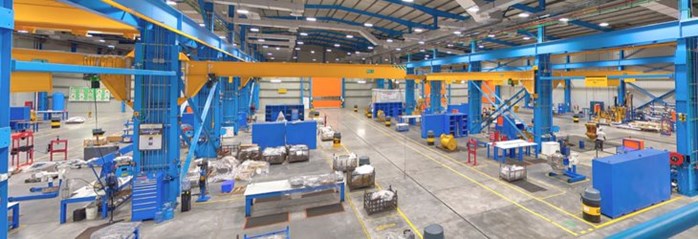
EQUIPPING THE MANTRAC CRC
The 12000-square-meter (129,167-square-foot) Mantrac CRC includes three different lines for three specific types of component rebuilds: engines, drivetrains and hydraulics.
The facility also includes a specialized salvage area or machine shop that includes lathes, boring and milling equipment used for general machining tasks, as well as a specialized twin arc metal spraying technology and a CNC machining center.
This equipment is used to rebuild worn parts of components to factory specifications and dimensions rather than replacing them. This lowers the overall cost of a component rebuild, significantly reduces waste, and enables the component to be rebuilt in Ghana — saving time and additional cost.
The majority of the components being rebuilt in the CRC are from Cat 785 and 777 trucks and related support equipment such as Cat 16 motor graders, D10 dozers and 992 wheel loaders.
Components of up to 6.0 meters (9.6 feet) long can be turned in the lathes and bores of up to 450 mm (18 inches) can be cut on the horizontal borer. Hydraulic cylinders up to 11 meters (36 feet) long and requiring up to 50,000 pound-foot of torque can be serviced on one of three benches, honed, and then fully tested after rebuild. Even the chrome on hydraulic cylinder rods can be repaired, using “brush plating” instead of incurring costs on an expensive replacement rod.
The CRC follows the latest equipment, tool and contamination control methodologies used for overhauling components. Every part is cleaned, inspected, measured and tested to Cat specifications.
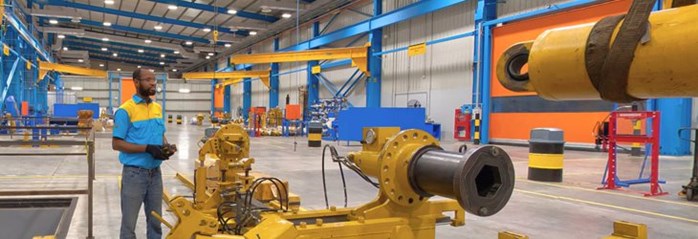
“We strictly adhere to Cat reusability guidelines to ensure that our customers’ equipment achieves peak efficiency at optimal costs,” says Andy Sarson, CRC Manager. “We also focus on continual improvement, with all of our tooling, systems and facility management being regularly benchmarked to ensure best-in-class performance.”
Each of the 108 bays in the workshop is covered by a 0.9-tonne (1-ton) capacity jib crane, which makes the handling parts and components efficient and safe and ensures nothing is damaged. Every bay is also covered by either a 13.6 or 18.1-tonne (15- or 20-ton) capacity overhead traveling crane.
In addition to meeting all of the standards Caterpillar has for CRCs, Mantrac has made additional investments in equipment and processes that make working in the Takoradi facility more efficient and easier on employees.
- An electronic component tracking and inspection system uses QR codes to track every part of every component throughout the rebuild cycle.
- All inspection reports are online, eliminating paper forms and improving overall process efficiency.
- Inspections are made in a specialized area that is equipped with a magnetic particle crack detector, digital measuring aids and other task-specific specialized tooling.
- Microscopes are used to compare surfaces to specification and reuse guides, ensuring that all critical parts are only reused if they pass stringent quality specifications.
Many labor-saving and fatigue-reducing devices are used through the facility, including tables that raise and lower engines and wheel stations to an ergonomically suitable working height, and automatic torque tools for large bolts.
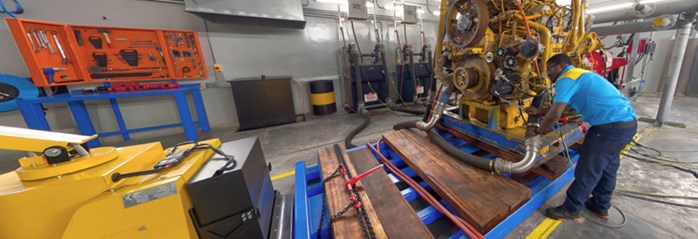
The CRC campus also includes a 2500-square-meter (26,910-square-foot) testing facility equipped with specialized equipment where all components are tested after being rebuilt.
Engines are tested using either the Taylor 1864 kW (2500 hp) capacity water brake dynamometer or the Taylor 2983 kW (4,000 hp) water brake dynamometer. Powertrain components, hydraulic pumps and motors are tested on either the Taylor 298 kW (400 hp) hydraulic test center or the Caterpillar 104 kW (140 hp) hydraulic test center.
Before dispatch back to customers, items are mounted on a compatible stand and paint is applied in the specialized paint booth. All openings are sealed and the component is shrink-wrapped, creating a factory-quality-level finished product.
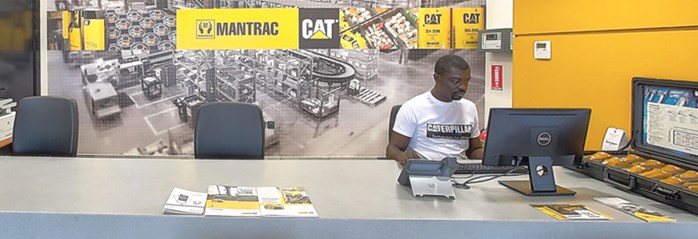
While the goal of the new CRC was to provide an important service to its customers in Ghana, the facility also demonstrates the dealership’s commitment to sustainability and the development of the local people.
The CRC employs over 120 Ghanaian staff. Careers begin and are advanced in the onsite training school and through on-the-job training, following many different curriculums covering all aspects of the company’s business.
The onsite training school has two classrooms capable of holding 40 students each. The classrooms are directly connected to the CRC, enabling components of any size to be brought into the classrooms for practical demonstration. In addition, a dedicated 250-square-meter (300-square-yard) workshop bay houses many components, work benches and special tools used for training staff not only on CRC processes but also on maintenance, systems and troubleshooting aspects for all Cat machines. The training facility is staffed by one supervisor, two instructors and one assessor.
Mantrac staff members are trained to a Caterpillar certified level. The dealership also promotes the Caterpillar Technicians for Africa program for people outside of the business who are interested in developing their knowledge of Cat equipment maintenance. Mantrac staff also provide training for customers either in the Mantrac facility or on their own sites.
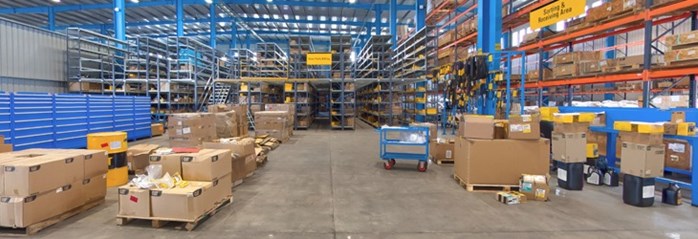
The Mantrac CRC site also includes a 5000-square-meter (53,820-square-foot parts distribution center. The warehouse stores not only new parts and components but also a large selection of service exchange and rebuilt components.
Spare parts out of Mantrac’s territorial distribution center are supplied to customers and all other Mantrac branches in the country via a dedicated fleet of delivery vehicles.
To allow its customers to see the new CRC while meeting social distancing guidelines during the COVID-19 pandemic, Mantrac has prepared a high-tech 360-degree virtual tour of the facility.